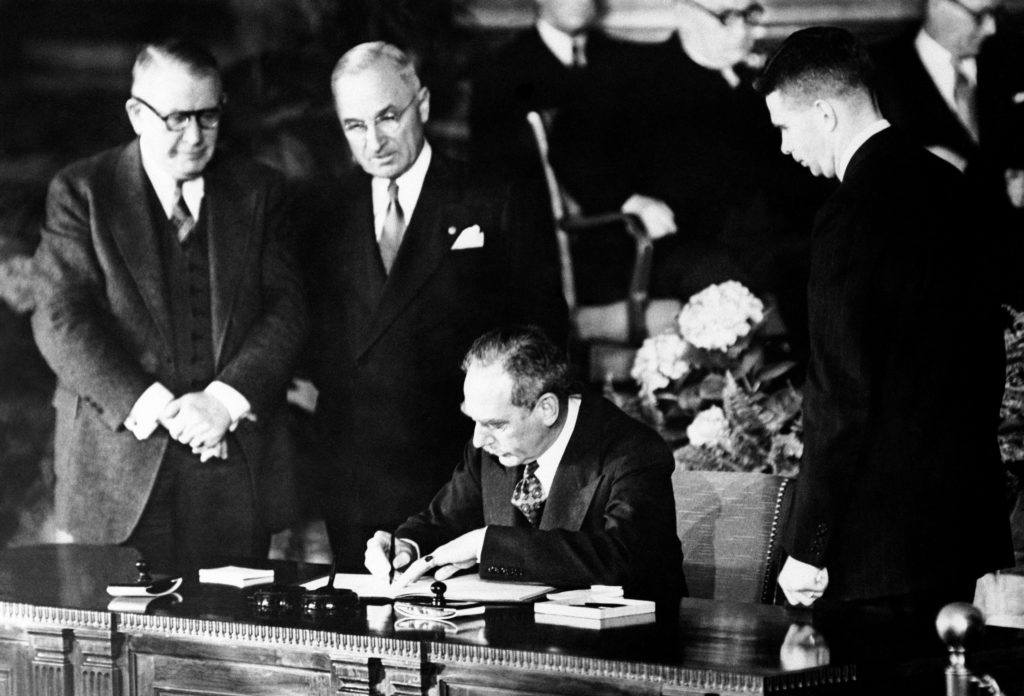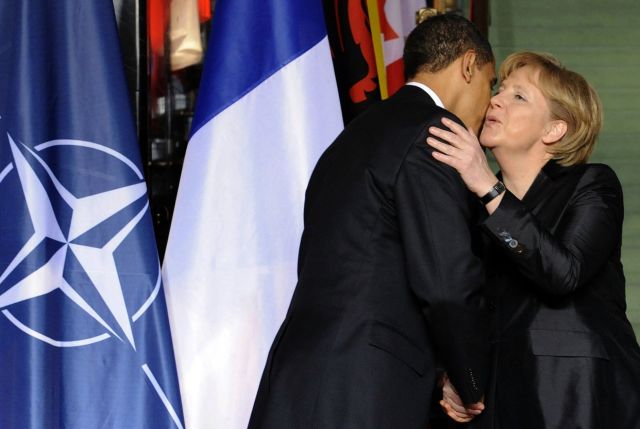President Obama and Angela Merkel at a Nato summit 2009, Marijan Murat/DPA/PA Images

In her Estonia address last week, ostensibly to British troops which are part of the Nato assurance mission there, but aimed at European capitals, Britain’s Prime Minister, Theresa May, said:
“[O]ur collective commitment to NATO’s Article 5 remains as strong as ever. And that an attack on any one of our NATO allies, would be treated as an attack on us all.”
Nato’s first secretary-general, Lord Ismay, who as General Sir Hastings “Pug” Ismay had been military secretary to Churchill’s war cabinet, famously said that the Alliance’s object was “to keep the Russians out, the Americans in, and the Germans down.”
When the words are repeated today they are usually accompanied by a wry smile, but has anything fundamentally changed in that statement of Nato’s core purpose? The Russians continue to sniff around the borders of Nato; the Americans seem distracted by events elsewhere; but what of Germany? Do they pose a threat? Yes, but of a rather different kind.
As ever, a little history is useful.
The origins of the Cold War
At the end of the Second World War, all the major powers kept sizeable forces in Germany as armies of occupation. In 1919 they had made the mistake of leaving Germany largely to herself, and in 1945 they were not going to repeat it. De-Nazification needed time and effort; law and order had to be guaranteed; and the population fed. With the switch from fighting to military government, however, the western allies began “de-militarising” their armies. But in the Soviet Zone, the Red Army stayed much as it was. They had the more brutal job of Stalinising Eastern Germany (and extracting reparations), and “Uncle Joe” did not trust his former allies. He had been caught out by the German invasion in 1941 (despite the two countries being signatories to a non-aggression pact), and he too had no intention of repeating a mistake.
With the breakdown of negotiations over the future of Germany, Stalin’s encouragement of a Communist coup in Czechoslovakia in 1948, and his blockade of Berlin in the same year, the British Army of the Rhine (BAOR) was hastily converted from a non-operational force of two divisions to an operational army of five divisions under the improvised direction of the new Western European Union comprising Britain, France and the Benelux countries. Without the integration of US forces in the WEU’s plans, however, the prospects of halting a Soviet offensive were slim; thus the creation of the North Atlantic Treaty Organisation in 1949.
The Soviet threat was perceived to rise critically in June 1950 with the outbreak of the Korean War, hastening the creation of a formal Nato military structure. A Supreme Commander Allied Forces Europe (SACEUR) was appointed in December: General Dwight D Eisenhower (later president of the United States), with Field Marshal Viscount Montgomery of Alamein as his deputy – the old, if tense, partnership that had liberated Europe in 1944-45. That command structure remains in essence to this day, with an American officer as SACEUR and a British officer as his deputy.
The post of Secretary General was not created until later – February 1952 – and since the headquarters had been moved from London to Paris, it was decided the position should be given to a Briton. Churchill, by then prime minister again, having defeated the Atlee government in October of the previous year, chose Ismay, his Secretary of State for Commonwealth Relations.
Since then only two other Britons have held the position: Margaret Thatcher’s former foreign secretary, Lord Carrington (from 1984 to 1988) and Tony Blair’s former defence secretary, George (Lord) Robertson (from 1999 until 2003). However, as I noted last week, the permanent chairman of the Nato Military Committee, which provides military advice to the Secretary General, will be the (British) Air Chief Marshal Sir Stuart Peach from next year. He’s currently the chief of the defence staff.
Collective security
The cornerstone of the Alliance, as Theresa May indicated in her Estonia speech, is Article 5 of the North Atlantic Treaty:
“The Parties agree that an armed attack against one or more of them in Europe or North America shall be considered an attack against them all and consequently they agree that, if such an armed attack occurs, each of them, in exercise of the right of individual or collective self-defence recognised by Article 51 of the Charter of the United Nations, will assist the Party or Parties so attacked by taking forthwith, individually and in concert with the other Parties, such action as it deems necessary, including the use of armed force, to restore and maintain the security of the North Atlantic area.
Any such armed attack and all measures taken as a result thereof shall immediately be reported to the Security Council. Such measures shall be terminated when the Security Council has taken the measures necessary to restore and maintain international peace and security.”
It is perhaps ironic that although Ismay’s central object was “to keep the Russians out”, Article 5 has been invoked just once, and in response to a wholly different kind of attack – that on the World Trade Centre in September 2001. However, it also demonstrates Nato’s deterrent effect when it comes to inter-state conflict.
Invoking Article 5 in the “war on terror” has certainly helped keep the Americans in – as has President Putin’s adventurism in Ukraine and the Middle East – but what about keeping the Germans down?

Despite the extensive post-war de-Nazification and re-education programme, the 1930s loomed large in the mind of Ismay’s generation. A resurgent, nationalist Germany remained a distinct possibility. In 1949, the Americans, British and French had combined their zones of occupation to establish a new nation, the Federal Republic of Germany, albeit with limited sovereignty (notably in foreign affairs and defence). Stalin responded by turning the Soviet Zone into the puppet German Democratic Republic. Just six years later, in May 1955, the western allies formally ended their military occupation of Germany, which now gained full sovereignty.
The Federal Republic at once joined Nato, despite the reluctance of some European nations, notably France, to see Germany re-arm, even as an ally. But Eisenhower, now president, believed that remilitarising West Germany was vital to containing Soviet expansion, and so reluctant European capitals fell into line. Having the Federal Republic’s forces under Nato control also reduced fear of German revanchism. (When in 1966 President de Gaulle withdrew France from the integrated military structure over arguments about nuclear policy, Germany simply did not figure in his concerns).
But of late, German membership of Nato is having unexpected and perverse consequences. Since reunification in 1990, Berlin has steadily reduced the Bundeswehr to the point that its capability is of serious concern. The parliamentary commissioner for the German armed forces (Bundeswehr), Hans-Peter Bartels, argued last year they were simply not fit for purpose[1. “Bartels found that only 38 of Germany’s 114 high-tech Eurofighter jets are operational, Deutsche Welles reported. It also has 93 Tornado fighter jets, but only 29 of them work. The number of German soldiers was around 600,000 at the end of the Cold War in the early 1990s. Today the country has just 177,000. These deficiencies have led to embarrassing episodes among the few foreign missions in which German forces are currently deployed.” Full report on Vice News, 27 January 20-16.]. This places a greater burden on the US in particular, as well allowing Chancellor Merkel more economic muscle to flex in Europe, including flirting with “Eurodefence” for purely political reasons. This has a dangerously disrupting effect on Nato because of the ambiguities of the EU’s security and defence policies, which Berlin is championing with Paris, though neither controls.
What of the French?
Ismay didn’t speak of the French. At the time they were not much of a military power, and their attention was focused on their old colonies in South-East Asia and North Africa. He probably thought, like his old boss, they were just another cross to bear (“The greatest cross I have to bear is the cross of Lorraine” was Churchill’s wartime judgment on de Gaulle). He was long retired when de Gaulle pulled France out of the integrated military structure.
In 2009, President Sarkozy brought France back in. He probably believed that the US was by then less suspicious of the EU’s Common Foreign Security Policy, and so if the French reintegrated fully with Nato, Washington would be less suspicious of the policy to beef up the the CFSP[2. “The Common Foreign and Security Policy (CFSP) is the organised, agreed foreign policy of the European Union for mainly security and defence diplomacy.”] with a military structure. The French had always given the impression that it was a question of alternatives: you could be a good European, or you could be a good Atlanticist; but you couldn’t be both. Sarkozy calculated that once properly back in Nato, Washington would no longer suspect France of wanting to use European defence to weaken the Alliance (or, indeed, the US). In other words, you could indeed “avoir votre gateau et le manger aussi.”
Marie Antoinette didn’t understand cake either.
There are two sides to the “Atlantic” in “Nato”
And the Americans? Ismay would be troubled that President Trump is not as committed to the Alliance as his predecessors. But Trump is right that too many members aren’t pulling their weight in terms of defence budgets. Probably, too, he is disconcerted that Paris and Berlin (and in Tony Blair’s time it was the same in London) are playing politics with defence.
Self-evidently, Nato’s core functions remain as Ismay first articulated them – keeping the Russians out by keeping the Americans in. But Ismay’s German object remains fundamentally important too – or rather, concern for (Franco-)German ambitions for an alternative EU defence identity. It is a myth that peace in Europe these past seventy years has been secured by the EU and its forerunners. Peace was, and is, guaranteed by Nato: Article 5 simply prevents any member going to war with another. The signal example is Greece and Turkey (indeed, Nato is Europe’s only real handle on Turkey).
Mrs May ended her speech in Estonia by saying:
“[W]hile we are leaving the European Union, as I have said many times, we are not leaving Europe. So the United Kingdom is unconditionally committed to maintaining Europe’s security. And we will continue to offer aid and assistance to EU member states that are the victims of armed aggression, terrorism…”
She made it clear that this was through Nato, however. Indeed, for it to be otherwise would be wasteful, complicating and destabilising.










Join the discussion
Join like minded readers that support our journalism by becoming a paid subscriber
To join the discussion in the comments, become a paid subscriber.
Join like minded readers that support our journalism, read unlimited articles and enjoy other subscriber-only benefits.
Subscribe